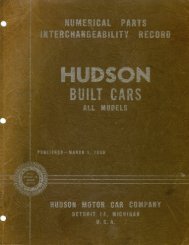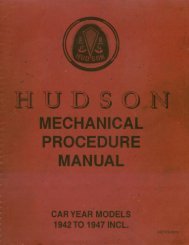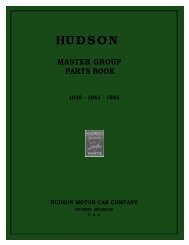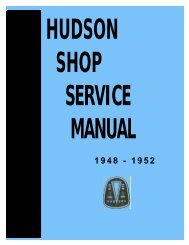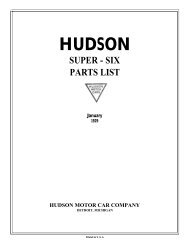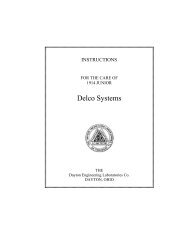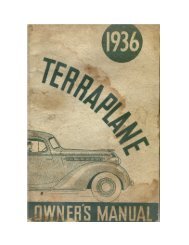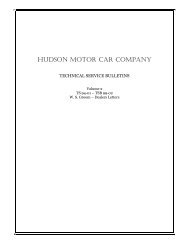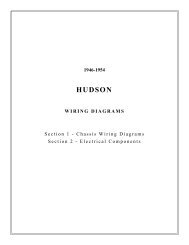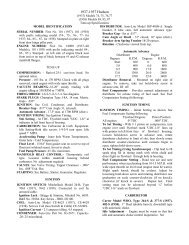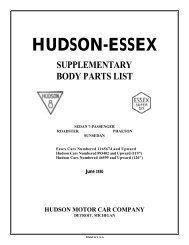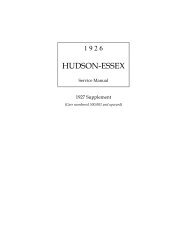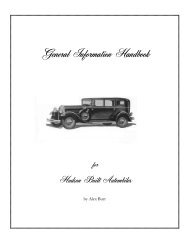1932 Essex Owners Manual - Hudson Essex Terraplane Club
1932 Essex Owners Manual - Hudson Essex Terraplane Club
1932 Essex Owners Manual - Hudson Essex Terraplane Club
Create successful ePaper yourself
Turn your PDF publications into a flip-book with our unique Google optimized e-Paper software.
INDEX<br />
General<br />
Page<br />
BREAKING-IN INSTRUCTIONS 11<br />
CARE OF THE FINISH 31<br />
LICENSE DATA AND TECHNICAL INFORMATION 5<br />
OPERATION 8<br />
STARTING THE ENGINE 10<br />
WARRANTY . 4<br />
Lubrication<br />
BRAKE CROSS SHAFT 20<br />
CHASSIS LUBRICATION CHART 12<br />
CLUTCH 15<br />
DISTRIBUTOR 14<br />
DOOR DOVETAILS 20<br />
DOOR LOCKS 20<br />
ENGINE 13<br />
FRONT WHEEL BEARINGS 19<br />
GENERATOR 14<br />
HOOD LEDGE LACINGS 20<br />
HOOD LOCKS 20<br />
REAR AXLE 18<br />
REAR WHEEL BEARINGS. 19<br />
STARTING MOTOR 14<br />
STEERING GEAR 20<br />
THROTTLE CONTROL RODS AND LEVERS 20<br />
TRANSMISSION 15<br />
UNIVERSAL JOINTS 18<br />
Adjustment<br />
BATTERY 25<br />
BRAKES 28<br />
CARBURETOR 23<br />
CLUTCH PEDAL 24<br />
FAN BELT 23<br />
FRONT WHEEL ALIGNMENT 28<br />
FRONT WHEEL BEARINGS 26<br />
HEADLAMPS 31<br />
IGNITION TIMING 21<br />
RADIATOR 30<br />
REAR WHEEL BEARINGS. 26<br />
SHOCK ABSORBERS 28<br />
SPARK PLUGS 30<br />
STEERING GEAR . 25<br />
TAPPETS 22<br />
TIMING CHAIN 22<br />
TIRES 27<br />
VACUUM TANK 24<br />
WHEELS - REMOVAL AND INSTALLATION 27<br />
WIRING DIAGRAM 16,17
Warranty<br />
"We warrant each new passenger automobile manufactured by us<br />
to be free from defects in material and workmanship under normal<br />
use and service, our obligation under this warranty being limited to<br />
making good at our factory any part or parts thereof, including all<br />
equipment or trade accessories (except tires) supplied by the Car<br />
Manufacturer, which shall, within ninety (90) days after making<br />
delivery of such vehicle to the original purchaser or before such<br />
vehicle has been driven 4000 miles, whichever event shall first<br />
occur, be returned to us with transportation charges prepaid, and<br />
which our examination shall disclose to our satisfaction to have<br />
been thus defective, this warranty being expressly in lieu of all<br />
other warranties expressed or implied and of all other obligations or<br />
liabilities on our part, and we neither assume nor authorize any<br />
other person to assume for us any liability in connection with the<br />
sale of our vehicles.<br />
"This warranty shall not apply to any vehicle which shall have been<br />
repaired or altered by other than an authorized <strong>Hudson</strong> and <strong>Essex</strong><br />
Distributor or Dealer in any way so as, in the judgment of the<br />
Manufacturer, to affect its stability or reliability nor which has been<br />
subject to misuse, negligence or accident."<br />
HUDSON MOTOR CAR COMPANY<br />
Detroit, Michigan, U. S. A.
ESSEX SUPER SIX<br />
TECHNICAL INFORMATION<br />
License Data<br />
CAR SERIAL NUMBER (On plate on dash under hood) - 1281685 and up<br />
ENGINE SERIAL NUMBER Stamped on left side of cylinder block opposite<br />
cylinder No. 3<br />
CYLINDER BORE - 2- 15 / 16<br />
"<br />
PISTON STROKE - 4¾ "<br />
NUMBER OP CYLINDERS 6<br />
N. A. C . C . HORSEPOWER RATING - 20.7<br />
PISTON DISPLACEMENT - 193<br />
Body Types<br />
STANDARD SEDAN<br />
COACH<br />
RUMBLE COUPE<br />
2-PASSENGER COUPE<br />
TOWN SEDAN<br />
SPECIAL SEDAN<br />
SPECIAL COUPE<br />
PHAETON<br />
CONVERTIBLE COUPE<br />
TYPE - 6 cylinders<br />
ACTUAL DEVELOPED H. P. - 70 at<br />
3200 R. P. M.<br />
COMPRESSION RATIO - 5.5 to I<br />
FIRING ORDER - 1-5-3-6-2--4<br />
NUMBER MAIN BEARINGS -3<br />
TYPE OF CRANKSHAFT-Fully<br />
Cornpensated; Statically and<br />
Dynamically Balanced<br />
MAIN BEARING CLEARANCE -<br />
.001"- .0015"<br />
MAIN BEARING END PLAY -<br />
.006".-.012"<br />
VALVE MATERIAL - Si1icon<br />
Chrome Alloy Steel<br />
VALVE HEAD DIAMETER - Jntake,<br />
.003"-.005"; Exhaust, .005”-.007”<br />
VALVE TAPPET CLEARANCE -<br />
Intake, .003"-.005"; Exhaust, .005"-<br />
.007"<br />
Measure with engine hot<br />
Technical Information<br />
Engine<br />
5<br />
CAMSHAFT DRIVE -Adjustable Silent<br />
Chain<br />
CONNECTING ROD LOWER<br />
BEARING<br />
CLEARANCE -- .001"-.0015"; Side<br />
Clearance, .006"-.010"<br />
PISTON MATERIAL --Silicon Aluminum<br />
Alloy<br />
PISTON TYPE - T Slot Cam Ground<br />
PISTON WEIGHT - 9¼ Ounces<br />
SKIRT CLEARANCE --Top, .0015"-<br />
.002"<br />
SKIRT CLEARANCE --Bottom,<br />
.0005"- 001"<br />
NUMBER OF PISTON RINGS -<br />
Compression, 2; Oil Control, 2<br />
PISTON RING GAP -.009"-.011"<br />
LUBRICATION -Duoflo Automatic<br />
System<br />
Oil Pump Type - Oscillating Plunger
ESSEX SUPER SIX<br />
TECHNICAL INFORMATION<br />
TYPE - Thermosiphon<br />
RADIATOR TYPE - Copper Ribbon<br />
Cellular<br />
CARBURETOR - 1¼" Marvel Air<br />
Valve Type<br />
AIR CLEANER - Flame Arrester<br />
Silencer Type<br />
SPARK CONTROL - Full Automatic<br />
TIMING - Dead Center<br />
FIRING ORDER 1-5-3-6-2-4<br />
DISTRIBUTOR POINT GAP - .020"<br />
STARK PLUG MAKE - A. C.<br />
Cooling System<br />
Fuel System<br />
Starting and Ignition<br />
COOLING SYSTEM CAPACITY -<br />
4-5/8 gals.<br />
FAN BELT - V Type<br />
FUEL FEED - Vacuum System with<br />
Vacuum Booster<br />
GASOLINE TANK CAPACITY - 12<br />
gals.<br />
SPARK PLUG TYPE - G-8 Metric<br />
SPARK PLUG GAP - .022"<br />
GENERATOR REGULATION -<br />
Third Brush<br />
GENERATOR NORMAL CHARG-<br />
ING RATE - Cold, 17 amps; Hot, 13<br />
amps.<br />
Lamp Bulb Specifications<br />
C.P. Base Voltage C.P. Base Voltage<br />
Head 32-32 D.C. 6-8 Dash 3 S.C. 6-8<br />
Side 3 S.C. 6-8 Stop & Tail 2-21 D.C. 6-8<br />
TYPE - Oil Cushioned Single Plate<br />
with<br />
Modulator Hub<br />
FEATURES - Full Range Selective<br />
Silent Second, Syncro-Mesh with<br />
Free Wheeling Automatic Retraction<br />
Reverse<br />
Clutch<br />
Transmission<br />
CLUTCH PEDAL CLEARANCE AT<br />
FLOOR<br />
BOARD - ¾"<br />
SPEEDS - 3 forward, 1 reverse<br />
6
ESSEX SUPER SIX<br />
TECHNICAL INFORMATION<br />
Semi-floating Type with Hotchkiss<br />
Drive<br />
One Piece Banjo Housing<br />
One Piece Differential Carrier with<br />
Offset Pinion for Equalized Bearing<br />
Loads<br />
TYPE - I-beam, Reverse Elliott with<br />
Inclined Spindle Pins<br />
SPINDLE PIN THRUST BEARING<br />
TYPE - Radial Thrust Ball Bearing<br />
TYPE - 4 Wheel Cable Control<br />
SIZE - 11" Diameter - Lining Width,<br />
1-3/4"; Thickness, 5/32"<br />
TYPE - Variable Pitch Worm and<br />
Sector<br />
GEAR REDUCTION - 15 to 1<br />
SIZE - 18 x 5.25<br />
PRESSURE - Average Driving, 32<br />
pounds, Front and Rear<br />
WHEELBASE - 113"<br />
Rear Axle<br />
Front Axle<br />
Brakes<br />
Steering Gear<br />
Tires<br />
Chassis Dimensions<br />
Keys<br />
Four Pinion Differential<br />
Heavy Duty Taper Roller Bearings<br />
Throughout<br />
Positive Oil Circulation to Pinion<br />
Bearings<br />
Positive Oil Seal at Wheel and Pinion<br />
Shafts<br />
TOE-IN - Zero to 1/8"<br />
CASTER ANGLE - Zero to 1º<br />
backward<br />
CAMBER - 1º<br />
TIE ROD - Rubber Silenced Joints<br />
CLEARANCE BETWEEN LINING<br />
AND DRUM - .008" at Anchor<br />
Pin End; .014" at Adjusting Screw<br />
End<br />
STEERING COLUMN HEIGHT -<br />
Adjustable to Five Positions<br />
High-Speed Driving, 40 pounds,<br />
Front and Rear<br />
OVERALL LENGTH (including<br />
bumpers) -177-1/2"<br />
Keys are numbered to correspond to the lock. Since it is necessary to conceal<br />
the number on the lock for theft protection, the key number should be noted on<br />
your Identification Card or in some other accessible place. Keys can be supplied<br />
only by number. For your own protection in case of loss of keys, record the<br />
numbers.<br />
7
ESSEX SUPER SIX<br />
OPERATION<br />
Operation<br />
The operation of the <strong>Essex</strong> Super Six follows standard practice in. many<br />
respects; however, even those accustomed to <strong>Essex</strong> products may refresh<br />
their memories on some of the details by reading the following paragraphs:<br />
The clutch is disengaged in the conventional manner by depressing the<br />
left foot pedal to release the engine drive from the transmission. Form the<br />
habit of keeping the foot off the clutch pedal except when shifting gears or<br />
coming to a stop.<br />
The transmission operation conforms to the standard shift. The clutch<br />
must be disengaged to shift gears except when the car is in motion and "free<br />
wheeling."<br />
8
ESSEX SUPER SIX<br />
OPERATION<br />
Free wheeling is obtained by pressing the button on top of the shifting<br />
lever knob and pulling the knob up until the button comes out flush with the<br />
top of the knob. To revert from "free wheeling" press the button and push<br />
down on the knob until the button comes out flush.<br />
It is possible to change to "free wheeling" at any time. To change from<br />
"free wheeling" to conventional drive when the engine is driving the car<br />
simply depress the button and knob. If the knob does not come out flush,<br />
release the accelerator pedal slightly while still pushing down on the knob.<br />
If the car is in motion and the engine is running at idling speed, increase<br />
the speed of the engine so that it drives the car, or depress the clutch before<br />
changing from "free wheeling" to conventional drive.<br />
The brakes are operated either by depressing the right foot pedal or<br />
pulling backward on the hand lever located on the driver's left just ahead of<br />
the front door.<br />
The engine speed can be controlled either by the foot accelerator or the<br />
throttle knob which is located on the instrument panel directly to the left of<br />
the light control knob.<br />
The light control knob is located directly to the left of the ignition lock.<br />
Pulling the knob out to the first position gives side lights and head lights in<br />
the second position. The head light control is located on the toe board to the<br />
left of the clutch pedal. If the head lights are on "bright" they are "dimmed"<br />
by pressing this foot control. A second depression of this control returns the<br />
lights to "bright."<br />
The dash lights are controlled by the switch extending below the instrument<br />
panel, slightly to the right of the choke control knob.<br />
The starter is controlled by the ignition lock. When the ignition key is<br />
turned to the right, the ignition is turned "on" and the starter is brought into<br />
operation. Should the engine stop while the key is turned to the right, the<br />
automatic starter will immediately engage and re-start the engine. If the car<br />
is in gear when the engine stalls, the clutch pedal should be depressed until<br />
the engine starts.<br />
If it is not desired to use the automatic starter after the engine has been<br />
started, the ignition key can be turned to the left. Turning the key to the left<br />
will also permit reading the gasoline or oil gauge and timing of the ignition<br />
without starting the engine.<br />
If it is desired to turn the engine by the starter without starting the engine, push the<br />
plunger which extends out of the rear face of the automatic starter relay box (under hood at<br />
left of engine). Hold the plunger down firmly and release quickly by sliding the finger off<br />
9
ESSEX SUPER SIX<br />
OPERATION<br />
sidewise to prevent the plunger sticking. Should the plunger stick so that the engine<br />
continues to turn, push it in again and release quickly.<br />
The carburetor choke control knob is located to the right of the ignition lock.<br />
(See "Starting the Engine" for use of choke.)<br />
The oil pressure signal is the red jewel located to the left of the center of the<br />
instrument panel. When the ignition switch is turned "on" this signal will be lighted<br />
and should stop glowing when the engine is running. If it remains lighted or flashes<br />
while the engine is running above idling speed, the engine should be stopped and<br />
the oil level in the reservoir checked. If neces sary, check the oil lines. Do not run<br />
the engine until the trouble is corrected.<br />
The generator signal is the red jewel located to the right of the center of the<br />
instrument panel. When the ignition switch is turned 11 on" this signal will be<br />
lighted and should stop glowing when the engine reaches a speed slightly above<br />
normal idling. If the signal flashes when the car is being driven above twenty miles<br />
per hour, it indicates that the battery is not being charged. Your electrical system<br />
should be checked by your <strong>Essex</strong> dealer.<br />
The "gasoline or oil" gauge indicates the quantity of gasoline in the tank when<br />
the ignition switch is turned either to the right or left position. By pushing upward<br />
on the button located below the instrument panel and slightly to the left of the light<br />
control knob, the hand of this gauge indicates the quantity of oil in the reservoir of<br />
the engine.<br />
The engine temperature indicator should show a reading within the driving<br />
range at all times when the car is being driven.<br />
The ride control knob on the instrument panel to the right of the choke knob<br />
gives maximum shock absorber control when pushed in and a "boulevard control"<br />
when pulled out.<br />
Starting the Engine<br />
The proper procedure in starting the engine is as follows: See that the throttle<br />
control knob is in. Do not open throttle with the accelerator until the engine starts.<br />
Pull the choke knob out as far as possible. Insert the ignition key in the lock and<br />
turn clockwise. When the engine "fires" push the choke in until it runs evenly. If<br />
the engine is cold, the choke can only be pushed in about three-eighths of an inch.<br />
Never leave the choke out farther than necessary to keep the engine running<br />
smoothly. It should be pushed in to the limit of its travel as soon as possible after<br />
starting the engine.<br />
10
ESSEX SUPER SIX<br />
OPERATION<br />
Breaking-in Instructions<br />
Keep Radiator Full<br />
Keep Oil Reservoir Full<br />
Heat is a major consideration in a new engine. Do not allow the engine to<br />
overheat. Although the heat indicator on the instrument panel shows the general<br />
temperature of the engine, it will not show a sudden rise in temperature of an<br />
individual part.<br />
The pressure imposed on parts such as bearings and pistons due to rapid<br />
acceleration or hard pulling will cause them to overheat if the car has not been<br />
driven sufficiently to break them in. Avoid fast acceleration and hard pulling while<br />
breaking in.<br />
High speed also develops higher operating temperatures and to avoid damage<br />
the car speed should be kept within the following recommendations:<br />
0-250 MILES<br />
Do not exceed 40 miles per hour in high gear or 20 miles per hour in second.<br />
Do not accelerate rapidly. Use second gear on steep grades. Keep motor<br />
temperature within "driving range" on dash heat indicator.<br />
250-500 MILES<br />
Do not exceed 50 miles per hour in high gear or 25 miles per hour in second.<br />
500-1000 MILES<br />
During this period the speed should not exceed 60 miles per hour.<br />
IMPORTANT<br />
Do not UNDER ANY CONSIDERATION attempt to maintain a high rate of<br />
speed unless the crankcase is full of good oil and until the engine is thoroughly<br />
warmed up. Cold oil is not able to flow freely into the small clearances between<br />
working parts so that damage may occur if sufficient time is not allowed for<br />
warming up before attempting high speeds.<br />
11
ESSEX SUPER SIX<br />
LUBRICATION<br />
Lubrication<br />
Engine<br />
Use High-Grade oil-Medium Heavy Body or S. A. E. 30<br />
Consult your dealer if you are in doubt<br />
as to what oil to use.<br />
When the ignition switch is turned on"<br />
the red jewel to the left of the center of the<br />
instrument board should flash red. If it<br />
does not, the bulb is either burned out, the<br />
circuit to the oil relief valve broken or the<br />
oil relief plunger sticking.<br />
lubrication system inspected.<br />
As soon as the engine is running, the<br />
light should go out. A flash of the red<br />
jewel while the engine is running<br />
above idling speed indicates interruption<br />
of the oil supply. The engine<br />
should be stopped immediately and the<br />
The amount of oil in the reservoir is shown on the gauge on the instrument<br />
panel marked "Gas or Oil" when the ignition electrolock is turned "on" (turn<br />
to left to read gauges without starting engine) and the button under the<br />
instrument panel below the gauge is pressed up.<br />
A bayonet gauge is also provided at the oil filler. See illustration.<br />
The <strong>Essex</strong> Duoflo oiling system provides not only purification from dilution<br />
but also double screening and cooling of the oil. The oil is therefore<br />
maintained in good condition for a longer time than in other lubricating<br />
systems. Oil should be added as necessary to maintain the quantity in the<br />
reservoir. The reservoir should be drained and refilled with six (6) quarts of<br />
oil at least every 2500 miles.<br />
It is, however, recommended to drain the initial supply of oil after the first<br />
500 miles of driving. To drain the reservoir remove the plug from the rear of<br />
the oil reservoir. Be sure the drain plug is tightened securely when replaced.<br />
13
ESSEX SUPER SIX<br />
LUBRICATION<br />
Distributor<br />
Use Motor Oil<br />
Fill distributor base to the level of the<br />
oil cup "C" with motor oil every 2000<br />
miles.<br />
Coat rotor cam "A" lightly with vaseline<br />
or light cup grease every 2000 miles.<br />
Apply a drop of oil at breaker arm<br />
pivot "B" every 2000 miles. Remove the<br />
rotor and apply a few drops of oil on top<br />
of shaft. Wipe excess oil from all parts.<br />
Care should be taken not to get oil on<br />
any parts of the distributor other than<br />
those specifically referred to as requiring<br />
lubrication. Do not over, lubricate.<br />
Generator<br />
Use Motor Oil<br />
Three or four drops of light motor oil<br />
at points "A" and "B" in the illustration<br />
every 1000 miles.<br />
Do not attempt to supply more oil than is<br />
required to fill the cups once, as excess<br />
oil may prevent proper operation of the<br />
unit.<br />
Starting Motor<br />
Use Motor Oil<br />
Three or four drops of light motor oil<br />
at points "A" and "B" in the illustration<br />
every 1000 miles.<br />
The oil cups on the starting motor have<br />
been made small to prevent over lubrication,<br />
which might find its way to the windings<br />
or commutator and eventually cause<br />
failure of the unit. Do not attempt to supply<br />
more oil than is required to fill the cups once.<br />
14
ESSEX SUPER SIX<br />
LUBRICATION<br />
Clutch<br />
Use 1/6 Pint of Light Motor Oil<br />
and 1/6 Pint of Kerosene<br />
The clutch lubricant is<br />
sealed into the clutch and supplies<br />
the driving surfaces as well<br />
as the throwout bearing with oil.<br />
The life of the lubricant is<br />
largely dependent on the usage of<br />
the clutch. Harsh clutch action<br />
indicates the need of fresh oil and<br />
the clutch should be promptly<br />
inspected by your <strong>Essex</strong> dealer if<br />
this condition develops. In any<br />
event, the oil should be changed<br />
at least every 15,000 miles.<br />
To drain the clutch, crank the engine by hand until the oil filler plug "A" on<br />
the front side of the flywheel is visible through the timing inspection hole.<br />
Remove the plug and turn engine slowly to allow lubricant to drain. Bring<br />
plug hole back to opening and insert new lubricant. Replace the drain plug<br />
securely.<br />
Transmission<br />
The lubricant in the transmission<br />
and free wheeling units should<br />
be maintained to the level of the<br />
filler<br />
plugs "A" and "B."<br />
The plugs "C" and -D" should be<br />
removed every 5000 miles and<br />
the lubricant drained out. Replace<br />
the plugs and fill through<br />
plug "B" with one quart of kerosene.<br />
Run engine with transmission<br />
in neutral and clutch<br />
engaged for one minute. Drain<br />
kerosene, replace drain plugs and<br />
fill through "B" with three pints of S. A. E. No. 110 gear oil (in winter use S.<br />
A. E. No. 80), allowing the oil to drain into the main transmission housing. If<br />
the full three pints cannot be put in at "B," add the balance at "A."<br />
It is essential that good oil of the proper body be used to insure proper<br />
protection against wear and permit proper gear changing. Buying according to<br />
15
16 - 17
ESSEX SUPER SIX<br />
LUBRICATION<br />
Universal joints<br />
Use Fiber Grease<br />
Remove the plug "A," shown in<br />
the illustration, of the rear universal<br />
joint and inject good fiber grease until<br />
grease appears at the vent hole in the<br />
shaft opposite the filler hole. There is a<br />
plug similarly located just back of the<br />
front universal joint for filling.<br />
The use of a proper grease at these<br />
points is very important in order to insure<br />
lubrication. These units should be<br />
filled every 2000 miles.<br />
The universal joints are often neglected until wear has occurred to such an<br />
extent that replacement is necessary. Wear at these points throws the propeller<br />
shaft out of balance, causing vibration, and thus offsets the care taken in<br />
manufacture to obtain accurate balance which is necessary for smooth operation<br />
at high speeds.<br />
Rear Axle<br />
Use High-Grade Gear Oil - Heavy Body<br />
or S.A.E. 110 in Summer - S.A.E. 90 in<br />
Winter<br />
The oil supply in the axle housing should<br />
be kept level with the lower edge of the filler<br />
plug opening "A."<br />
There are special oil passages and baffles in<br />
the differential carrier housing which catch<br />
oil thrown from the ring gear and carry it to<br />
the pinion hearings and return the overflow to the axle housing. This keeps the<br />
pinion bearings under a constant bath of oil and eliminates the necessity of<br />
oiling them separately. Select a good oil that will flow at low temperatures.<br />
Every 5000 miles drain, flush out with kerosene and refill.<br />
Housing may be drained by removing cover "B."<br />
18
ESSEX SUPER SIX<br />
LUBRICATION<br />
Front Wheel Bearings<br />
Use Cup Grease<br />
The front wheel bearings should be lubricated<br />
every 5000 miles. Jack up the<br />
front of the car and remove the wheel from<br />
the hub. (See page 27 for method of removing<br />
and installing wheels.)<br />
Remove the inside hub cap and withdraw<br />
the cotter key, holding the nut "B."<br />
Unscrew the nut "B" and remove the<br />
washer "C." The hub and brake drum can<br />
then be removed and the bearing and inside<br />
of the hub and drum washed out with kerosene.<br />
Pack the bearings and hub with three<br />
ounces of cup grease. Renew the felt<br />
washer at the inner end of the hub, if necessary. Replace wheel. (See page 26 for<br />
bearing adjustment.)<br />
Rear Wheel Bearings<br />
Use Cup Grease<br />
The rear wheel bearings should be<br />
lubricated every 5000 miles. Jack up<br />
rear of car and remove the wheel from<br />
the hub. (See page 27 for method of<br />
removing and installing wheels.)<br />
Withdraw cotter key and remove nut<br />
from end of axle shaft. Pull hub and<br />
brake drum off the shaft.<br />
Unscrew four screws holding<br />
grease deflector "A" and remove deflector.<br />
Remove four screws from<br />
bearing cap "B" and remove cap and shims "C." ounces of grease in the<br />
housing. Remove bearing and insert ten (10) ounces of grease in the housing<br />
Wash the cap and bearing in kerosene and replace bearing after filling<br />
with grease. Renew the felt washer in the bearing cap, if necessary. Replace<br />
shims and bearing cap. Replace the grease deflector. See that all brake parts<br />
and the brake drum are free from grease before replacing the hub and wheel.<br />
19
ESSEX SUPER SIX<br />
LUBRICATION<br />
Steering Gear<br />
Use High-Grade Gear Oil<br />
- Heavy Body<br />
Remove plug "A" and fill the steering<br />
gear housing every 2000 miles. The<br />
use of a good grade heavy bodied gear oil<br />
is necessary to provide free operation under<br />
all climatic conditions. (Do not use<br />
grease.)<br />
If the steering becomes stiff and<br />
complete lubrication of the unit and the<br />
attached parts connecting with the front<br />
wheels does not correct the condition, follow<br />
the instructions on page 25 for adjustment<br />
and alignment of the steering gear.<br />
Noise in the unit may be due to use of oil of insufficient body. Stiff operation<br />
may be experienced in cold weather if poor oil or grease is used.<br />
Miscellaneous<br />
THROTTLE CONTROL RODS AND LEVERS - Oil or grease all<br />
accelerator connections. Throttle linkage should work with a snap. Grease<br />
choke and throttle wire occasionally to eliminate sticking.<br />
BRAKE CROSS SHAFT - Coat brake cross shaft pivot pins with light<br />
cup grease every 1000 miles. Do not allow oil or grease to collect inside of<br />
brake drum.<br />
HOOD LEDGE LACINGS - Use motor oil. Saturate with motor oil<br />
frequently to remove squeaks and preserve lacing.<br />
HOOD LOCKS - Use motor oil. Lubricate occasionally by injecting a few<br />
drops of oil through hole in the barrel just below the handle.<br />
DOOR LOCKS - Use motor oil. Lubricate occasionally with a few drops<br />
of oil on the latch bar. Work lock several times to spread oil, then wipe off<br />
excess.<br />
DOOR DOVETAILS - Lubricate with grease or soap. Wipe off excess.<br />
DOOR HINGES - Lubricate with light oil. Wipe off excess.<br />
20
ESSEX SUPER SIX<br />
ADJUSTMENT<br />
Adjustment<br />
Ignition Timing<br />
Remove distributor cap and inspect<br />
points and clean if necessary. Place<br />
breaker point file between points and<br />
let them close against file under their<br />
normal spring pressure. Move file<br />
straight up and down, dressing both<br />
points at the same time.<br />
.020". Tighten lock nut.<br />
Crank engine with the hand crank until<br />
the breaker arm fiber block is on the<br />
highest point of the cam, giving the<br />
points their maximum opening. If necessary<br />
to adjust, loosen lock nut "D"<br />
and turn screw "E" until the gap is<br />
Remove the spark plug from number one cylinder. Crank the engine<br />
slowly by hand until air is forced out through the spark plug hole. Continue<br />
turning the engine slowly until the D. C. 1 and 6 mark is exactly in line with<br />
the pointer as shown at "A."<br />
Loosen clamp screw "B" and turn<br />
distributor clockwise to the full limit<br />
permitted by the slot in the clamping<br />
plate "C."<br />
Turn the distributor counterclockwise<br />
until the points have just begun to<br />
open. Tighten lock screw" B. "<br />
When the engine is in this position<br />
the rotor arm "F" will point directly to<br />
the sector in the distributor cap to<br />
which number one spark plug cable is<br />
connected. Following around the cap<br />
clockwise from this point the spark<br />
plug wires should be in the following<br />
order: 1-5-3-6-2-4.<br />
21
ESSEX SUPER SIX<br />
ADJUSTMENT<br />
Tappets<br />
Before adjusting tappets see that<br />
the tappet clamp cap screw "C" is<br />
tight. Adjust tappet by loosening lock<br />
nut "B" and turning adjusting screw<br />
"A." Lock adjustment by tightening<br />
lock nut "B" while holding screw "A"<br />
Measure clearance between adjusting<br />
screw and end of valve stem<br />
with a feeler gauge as shown at "D" in<br />
the illustration. This measurement<br />
should be made while the engine is at<br />
its normal operating temperature.<br />
Adjust exhaust valve tappets to .006" clearance and intake tappets to<br />
.004" clearance.<br />
Counting from the front the exhaust tappets are 1-3-6-7-10-12 and the<br />
intake tappets are 2-4-5-8-9-11.<br />
Always adjust tappets after grinding valves.<br />
Timing Chain<br />
The timing chain should be inspected<br />
at the expiration of the first 1500<br />
miles and at intervals of 5000 miles<br />
thereafter.<br />
A to and fro movement of approximately<br />
1/8" on the circumference of the<br />
coupling "A" (after the slack around the<br />
coupling bolt is taken up) should be<br />
maintained.<br />
To adjust, loosen the three retaining<br />
bolts "B." The inside top bolt and the<br />
bottom bolt (not shown) pass through<br />
the notches in the eccentric, necessitating<br />
their removal. Insert special tool "C"<br />
in notch and pull toward you until only the required movement of the coupling is<br />
present. If trouble is experienced in replacing the bolts, back off the adjustment<br />
slightly, allowing them to slide into place.<br />
One half pint of motor oil should be introduced through the pipe plug opening<br />
"D" whenever the distributor support housing has been removed.<br />
22
ESSEX SUPER SIX<br />
ADJUSTMENT<br />
Fan Belt<br />
Carburetor<br />
The fan belt must be kept at the<br />
proper tension to prevent slippage on<br />
the pulleys; however, an excessively<br />
tight belt will throw a heavy load on the<br />
fan bearings and cause rapid wear.<br />
To adjust the belt, loosen the nut "A"<br />
and raise or lower the fan as necessary<br />
until the two sides of the belt can be<br />
drawn within 3/4' of each other, as<br />
shown at "B." Tighten lock nut "A"<br />
securely.<br />
When adjusting the fan see that the<br />
fan pulley is in line with the crankshaft<br />
pulley so that the belt runs straight in<br />
the pulley grooves. Proper alignment<br />
can be obtained by sliding the fan support<br />
arm backward or forward on the<br />
supporting stud.<br />
Spark plugs and breaker points should be cleaned, spark gaps properly spaced<br />
and all residue in gasoline passages removed before adjusting the carburetor.<br />
Remove filter glass on vacuum tank to stop flow of gasoline to carburetor while<br />
cleaning. See illustration, page 24.<br />
Adjust set screw "D" for faster or<br />
slower idling speed. The correct idling<br />
speed is seven miles per hour.<br />
Adjust air screw "A" to change mixture<br />
for smoother idling. Turn air screw<br />
until the end is flush with the end of the<br />
ratchet spring bearing against it. This is<br />
the normal adjustment and the final setting<br />
should not be more than 1/2 turn<br />
either way from this point. Warm engine<br />
to proper operating temperature. Turn air<br />
screw counterclockwise until the engine<br />
hesitates, then clockwise one notch at a<br />
time until the engine runs smoothly. The<br />
heat supplied to the carburetor from the<br />
exhaust is automatically controlled by a<br />
thermostat and requires no adjustment.<br />
The air cleaner unit should be cleaned every 2500 miles, except under extremely<br />
dusty operating conditions when the cleaning should he more frequent.<br />
Remove the cleaner and wash in gasoline and then soak filter element only with<br />
motor oil. Drain off excess oil and replace.<br />
23
ESSEX SUPER SIX<br />
ADJUSTMENT<br />
Vacuum Tank<br />
The glass sediment chamber at<br />
the bottom of the vacuum tank should<br />
be removed and cleaned whenever its<br />
contents show an accumulation of water<br />
or dirt. The water, due to the fact<br />
that it is heavier than gasoline, settles<br />
to the bottom of the glass and is easily<br />
distinguished.<br />
The flow of gasoline is automatically<br />
shut off as soon as the glass is<br />
removed, so that it is only necessary to<br />
hold the glass "A" in one hand, loosen<br />
the thumbscrew "B," and swing the<br />
bracket "C" to one side to empty the<br />
glass.<br />
The removal of the sediment<br />
chamber also acts as a cut-off so that<br />
the carburetor feed line can be removed<br />
without loss of gasoline from<br />
the vacuum tank.<br />
Clutch Pedal<br />
A clearance of 3/4" must be maintained<br />
between the clutch pedal shank<br />
and the toe board, as shown in the<br />
illustration at "A."<br />
This adjustment should be made accurately,<br />
as too much clearance will<br />
reduce the pedal movement and may<br />
prevent complete clutch disengagement,<br />
causing hard shifting. Too little<br />
clearance may, after slight wear of the<br />
clutch disc facing, permit the clutch<br />
pedal to rest against the toe board and<br />
hold the clutch in partial disengagement.<br />
This will cause slippage and<br />
rapid wear.<br />
To adjust, remove the clevis pin "B" and loosen the lock nut "C." Turn the<br />
yoke on the link to obtain proper length. Lengthening the link increases the<br />
clearance between the clutch pedal shank and the toe board, while shortening<br />
the link reduces it.<br />
24
ESSEX SUPER SIX<br />
ADJUSTMENT<br />
Steering Gear<br />
The bearings on the steering gear<br />
worm shaft are preloaded by the pressure<br />
of a spring located between the<br />
outer race of the upper bearing and<br />
cover plate. This spring pressure prevents<br />
development of end play in the<br />
worm, so that no adjustment is necessary<br />
to take care of normal wear.<br />
To remove side play in cross shaft:<br />
The adjustment for cross shaft "F" is<br />
on the opposite end to that shown in<br />
the illustration. Loosen the lock nut<br />
and with a screwdriver turn the adjusting<br />
screw down as tightly as possible,<br />
then back up slightly. Tighten<br />
lock nut.<br />
To remove play in mesh of worm<br />
and cross shaft sector: Locate wheels<br />
in straight-ahead position, disconnect drag link from steering arm and shake<br />
arm to determine the amount of play. Loosen four stud nuts "D" (1/4 turn<br />
only). Turn eccentric sleeve "C" to right or clockwise direction only in<br />
gradual stages, noting result by shaking steering arm at each step and using<br />
care at last stage to turn sleeve just sufficiently to remove play and no further.<br />
Securely tighten cover stud nuts "D."<br />
To change position of steering wheel to suit requirements of driver: It is<br />
necessary to loosen frame bracket stud nuts "E," as well as cowl bracket nut<br />
under cowl, then set steering wheel at desired position.<br />
Keep the steering column to dash clamp bolt, the cross shaft nut "G" and<br />
the frame stud nuts "E" tight.<br />
Battery<br />
Periodically disconnect terminal "A" from the battery. Clean thoroughly,<br />
coat with vaseline, replace and<br />
tighten securely.<br />
Battery must be kept securely fastened<br />
in tray. Tighten at "B."<br />
Inspect battery liquid at least every<br />
two weeks in warm weather<br />
(required less frequently in cooler<br />
weather) and add distilled water at<br />
openings "C" to cover plates if necessary.<br />
25
ESSEX SUPER SIX<br />
ADJUSTMENT<br />
Front Wheel Bearings<br />
The adjustment of the front wheel bearings<br />
is important, as it affects braking<br />
and steering, as well as the free running<br />
of the car.<br />
To adjust the front wheel bearings, jack<br />
up the front wheel, remove the inner and<br />
outer hub caps and withdraw cotter key<br />
holding nut -B.- Tighten nut "B" until a<br />
slight drag is felt when turning the<br />
wheel slowly by hand. Loosen the nut<br />
just sufficiently to permit the wheel to<br />
turn freely, insert cotter key and replace<br />
hub caps.<br />
Rear Wheel Bearings<br />
To adjust rear wheel bearings, jack up<br />
rear of car and remove both rear<br />
wheels. (See page 27 for method of<br />
removing wheels.) Remove wheel<br />
hubs as described under "Rear Wheel<br />
Bearings." (See page 19.)<br />
Unscrew four screws holding<br />
grease deflector "A" and remove deflector.<br />
Remove four screws from<br />
bearing cap "B" and remove cap. By<br />
reducing the number of shims under<br />
the cap, the end play of the axle shaft<br />
is decreased, and the installation of additional, shims increases the end play.<br />
Total end play between the axle shafts should be from .004" to.010",<br />
which amount is perceptible when pulling the axle shaft in and out.<br />
Approximately the same thickness of shims should be used under each<br />
bearing cap so that the brake drums will be evenly spaced from the brake dust<br />
shields.<br />
26
ESSEX SUPER SIX<br />
ADJUSTMENT<br />
Removal and Installation of Wheels<br />
To remove either the demountable<br />
wood or wire wheels, place a screw,<br />
driver behind the hub cap and pry off.<br />
Loosen the five cap screws "A" with<br />
the socket wrench provided in the tool<br />
kit. Remove the cap screw "A" which<br />
is at the lowest position on the wheel<br />
and insert the handle of the wrench<br />
through the screw hole in the wheel<br />
into the hub. While holding the wheel<br />
in position with the wrench, remove<br />
the other cap screws "A" and lift off<br />
the wheel.<br />
When reinstalling the wheel, jack<br />
up the car so that there is just sufficient<br />
clearance for the wheel to slide onto<br />
the hub. Place the handle of the wrench through the lower cap screw hole in the<br />
wheel and the drum. Lift up on the wrench so that the wheel will clear the ground<br />
and push the wheel in place. Align the screw holes by moving the wrench back<br />
and forth. While holding the wheel in place with the wrench, start at least two of<br />
the cap screws. Remove the wrench and start the remainder of the screws.<br />
Tighten every other cap screw until all are down just enough to hold the<br />
wheel in place to be sure it is square on the hub. Tighten every other cap screw,<br />
continuing around until all screws are securely tightened.<br />
Tires<br />
Check tires once a week and keep inflated to 32 pounds pressure. For fast<br />
driving inflate tires to 40 pounds. Be sure front tire pressures are equalized,<br />
To remove the tires from the wheels, let all air out of the tube. Push valve stem<br />
up into tire. Starting at the valve stem, press the beads of the tire together and into<br />
the base of the rim for about one foot in each direction. Insert an iron under both<br />
beads directly opposite the valve and force the tire over the rim. The tire can then<br />
be lifted off.<br />
To install a tire, inflate the tube until it is barely round and place it in the casing<br />
with the valve stem in line with the red dot on the side wall of the casing to<br />
preserve the tire balance. Press the beads of the tire together at the valve stem and<br />
place tire on wheel so that the beads go to the bottom of the rim well and the<br />
valve stem enters the hole in the rim. Working both ways from the valve stem,<br />
press the beads together and down into the rim well until the portion of the tire<br />
opposite the valve can be forced over the rim. Raise tire up and allow beads to<br />
spread until the tire is centered on the rim. Inflate tube to five pounds pressure<br />
and work tire back and forth to insure proper seating of tire on rim. Inflate to<br />
proper operating pressure.<br />
27
ESSEX SUPER SIX<br />
ADJUSTMENT<br />
Brakes<br />
When the brake pedal travels to<br />
within 1-1/2" of the toe board, the<br />
brakes should be adjusted as follows:<br />
Jack up all four wheels and remove<br />
the inspection cover "A" from the<br />
brake drum. Turn the brake drum as<br />
necessary and insert a .014" feeler<br />
between the drum and the lining 1-1/<br />
2" from the adjusting screw end (rear<br />
of front brakes-front of rear brakes)<br />
of the lining of the upper shoe.<br />
Loosen the eccentric lock nut "B"<br />
and turn the eccentric "C" in the<br />
direction the wheel rotates when the<br />
car is moving forward until the<br />
feeler is held snugly.<br />
Adjust all four wheels as outlined above. Depress the brake pedal to within<br />
3-1/2" of the toe board. Try the braking effect by pulling each wheel over by<br />
hand. If the braking effect is unequal, or insufficient, adjust by removing the<br />
adjusting hole cover "D" and inserting adjusting tool or screwdriver in hole<br />
"E" and engaging adjusting screw ratchet. Move hand end of tool toward the<br />
axle to increase, and away from axle to decrease, braking effect.<br />
Front Wheel Alignment<br />
Measure the distances "A" and "D"<br />
as shown in the illustration. The distance<br />
"A" should be the same as "D,"<br />
or not over 1/8" longer - never shorter.<br />
A special tool should be used for<br />
this purpose and the measurement<br />
taken between the rims at a height<br />
about even with the hubs. Loosen<br />
clamp bolts "B" and turn tie rod "C"<br />
clockwise, as viewed from the right, to increase "A" and counterclockwise to<br />
decrease "A."<br />
Shock Absorbers<br />
The shock absorbers should be refilled every 2000 miles. The special fluid<br />
required for this purpose can be obtained from your dealer. Do not use any<br />
other liquid as there is a possibility of destroying the unit, especially in cold<br />
weather, should the liquid become thick or frozen.<br />
Keep the shock absorbers tight on the frame at all times and do not permit<br />
any play to develop in the linkage.<br />
All repairs and adjustments, including refilling of the shock absorbers,<br />
should be made by an authorized <strong>Essex</strong> or Monroe Service Station.<br />
28
ESSEX SUPER SIX<br />
ADJUSTMENT<br />
Spring Mountings<br />
Chassis noise, erratic spring action<br />
and wandering of the car on the road<br />
can often be attributed to spring<br />
mountings.<br />
Adjust the spring shackles to remove<br />
end play of spring on shackle<br />
bolt by loosening the locking nut "A"<br />
and turning the bolt "B" until tight,<br />
then turn back one sixth turn and<br />
tighten nut "A."<br />
This operation should be performed<br />
every 5000 miles on both upper<br />
and lower shackle bolts at the rear<br />
of both the front and rear springs and<br />
on the anchor bolts (not illustrated),<br />
holding the front ends of front and rear<br />
springs to the frame brackets.<br />
The spring clip nuts (front and rear)<br />
shown in the illustration should be<br />
tightened every 5000 miles.<br />
When making the above adjustments<br />
the body hold down bolts<br />
should also be tightened. There are<br />
eight of these, four on each side, located<br />
just outside the frame side mem-<br />
29
ESSEX SUPER SIX<br />
ADJUSTMENT<br />
Radiator<br />
Drain, flush out and refill frequently.<br />
Filler is located under the hood to<br />
eliminate possibility of anti-freeze<br />
ruining the finish.<br />
About every four months a solution<br />
consisting of one pound of washing<br />
soda to four gallons of water<br />
should be poured into the radiator<br />
and allowed to slowly circulate<br />
through the system by running the<br />
engine at idling speed. Leave drain<br />
cock open and thoroughly flush out<br />
after cleaning.<br />
See that hose is in good condition and all hose clamps are tight.<br />
Do not allow mud, etc., to clog air passages through radiator.<br />
Repair dents and leaks when they occur.<br />
Add an anti-freeze solution to the radiator in cold weather.<br />
Drain enough water from the radiator so that after the anti-freeze has been<br />
added there will still be room for a slight expansion of the liquid without its<br />
running over the overflow pipe.<br />
Add Anti-Freeze as Follows:<br />
For Ethylene Radiator<br />
Glycol or Alcohol or Glycerine<br />
32º to 10º above 0º 5-1/2 qts. 6-2/3 qts. 9-1/4 qts.<br />
10º to 0º 7 qts. 8-2/3 qts. 11-1/2 qts<br />
0º to 10º below 0º 8-1/3 qts. 10 qts. 13-2/3 qts.<br />
10º to 20º below 0º 9-1/2 qts. 11-1/4 qts. 15-1/3 qts.<br />
Spark Plugs<br />
When setting the gap of the spark plugs, make all adjustments by moving<br />
the side wire. Do not bend center wire as this may break the porcelain.<br />
To clean the carbon from the porcelain, fill the lower part of the plug with<br />
alcohol, liquid metal polish or equal parts of ammonia and water, and allow<br />
it to stand for a few seconds. Take a piece of wire covered with one thickness<br />
of cloth and rub the carbon from the insulator, wiping thoroughly dry before<br />
replacing the plug in the engine.<br />
Spark plugs should be changed every 10,000 miles for better engine<br />
performance. New spark plugs give quicker starting, increased power,<br />
smooth running and a saving in gasoline.<br />
30
ESSEX SUPER SIX<br />
ADJUSTMENT<br />
Headlamps<br />
Place the vehicle under normal load on a level floor squarely facing a smooth<br />
wall 25 feet from the headlamps.<br />
Measure the height of the lamp bulbs from the ground and draw a horizontal line<br />
on the wall at the same height as the bulbs.<br />
Sight through windshield along hood rod and radiator cap to determine the<br />
center line of the vehicle. Locate center lines of lamps on the wall from this line.<br />
With the head light control in the position throwing the light beam farthest from<br />
the vehicle, cover left lamp to obscure its light beam. Loosen the right mounting<br />
nut (located under fender apron) and aim the right lamp so that the top of the beam<br />
is just even with the horizontal line and equal portions on each side of the center<br />
line of right lamp.<br />
Repeat operations with the left lamp and the headlamps will be properly aligned.<br />
Care of the Finish<br />
The same care should be exercised in washing and cleaning cars finished<br />
in lacquer or enamel as is employed in the handling of varnished surfaces.<br />
Dry dirt accumulations should not be wiped off but should be softened and<br />
removed by thoroughly soaking the body with flowing water, applied under<br />
light pressure.<br />
After careful washing of the car, an application of <strong>Hudson</strong>-<strong>Essex</strong> polish is<br />
recommended. This high-grade cleaner and polish, especially prepared for<br />
lacquer and enameled surfaces, may be obtained from your <strong>Hudson</strong>-<strong>Essex</strong><br />
dealer and its periodic use will maintain the original high luster and preserve<br />
the finish. Polishes containing strong abrasives are particularly destructive to<br />
the striping and their use should be avoided. Anti-freeze solutions containing<br />
alcohol when accidentally spilled on the finish should be immediately<br />
washed off with clear water to prevent spotting, as alcohol is a solvent of<br />
lacquer.



